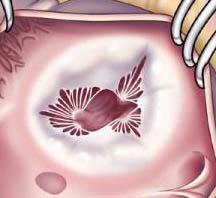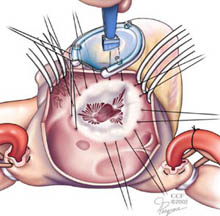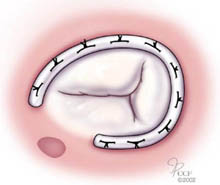Tricuspid Valve Disease
What is tricuspid valve disease?
For more information on valve disease and its treatment, see Valve Disease
The tricuspid valve is located between the right atrium (top chamber) and right ventricle (bottom chamber). Its role is to make sure blood flows in a forward direction from the right atrium to the ventricle.
Tricuspid valve disease refers to abnormal function of the tricuspid valve. Two types of tricuspid disease include:
- Tricuspid regurgitation - the valve is leaky or doesn't close tight enough, causing blood to leak backwards across the valve
- Tricuspid stenosis - the valve leaflets are stiff and do not open widely enough, causing a restriction in the forward flow of blood. Your physician may refer to this as an increased pressure gradient
across the valve, found by echocardiogram or cardiac catheterization.
Tricuspid Regurgitation
Tricuspid valve disease can be caused by
- Infection, such as rheumatic fever or infective endocarditis
- A dilated right ventricle, causing the annulus (a ring of tough fibrous tissue which is attached to and supports the leaflets of the valve) of the tricuspid valve to enlarge
- Increased pressure through the tricuspid valve (seen with pulmonary hypertension)
- Less common causes include congenital defects, trauma, carcinoid heart disease, tumor, tricuspid valve prolapse, Ebstein's anomaly, systemic lupus, and trauma.
Tricuspid valve disease, if caused by rheumatic fever, is often combined with mitral and/or aortic valve disease.
SYMPTOMS AND CAUSES
 Edwards MC³ Annuloplasty System
Edwards MC³ Annuloplasty System
What are the symptoms?
Tricuspid valve disease may be tolerated for a long time without any symptoms.
Symptoms may include:
- Irregular heart rhythm (atrial fibrillation)
- Easily tired (fatigue)
- A fluttering discomfort in the neck
- With severe disease, heart failure symptoms (right abdominal pain, shortness of breath, swelling in the legs or abdomen, cold skin)
DIAGNOSIS AND TESTS
How is tricuspid valve disease diagnosed?
Tricuspid valve disease may first be diagnosed during a physical exam. The doctor will often hear a murmur (abnormal blood flow through the valve). Other signs your doctor may find are an irregular pulse and a fluttering or abnormal pulsation in your neck (jugular vein).
Tests used to diagnose valve disease may include:
- Electrocardiography (ECG)
- Chest X-ray
- Echocardiography
- Transesophageal echocardiography
- Cardiac Catheterization (cardiac cath or angiogram)
- Radionuclide scans
- Magnetic resonance imaging (MRI)
- Find more information about these diagnostic tests
MANAGEMENT AND TREATMENT
How is it treated?
Medical Management
- Your doctor will want to monitor the progress of your valve disease with regular appointments. They may be spaced once a year or more often, if your doctor feels you need to be followed more closely.
- Your appointment will include a medical exam. Diagnostic studies may be repeated at regular intervals.
- Your physician may prescribe medications to treat your symptoms. These medications may include drugs to treat heart failure or medications to control irregular heart rhythms.
Lanyard and template handle assists with placement of ring
Surgical Management
Tricuspid Valve Repair
When valve disease is severe, it may be necessary to repair or replace the diseased valve. Tricuspid valve repair using an annuloplasty ring is the preferred surgical approach for tricuspid regurgitation and may be performed for primary tricuspid disease or for combined cases with other valve surgery (mitral, aortic). See illustrations to the right. For more information and to view actual surgery, see: Movie: Edwards MC³ Tricuspid Annuloplasty*
When the valve can not be repaired, a valve replacement will be performed. Find more information about tricuspid valve surgery.
Endocarditis prevention
If you have tricuspid valve disease, you are at risk for getting endocarditis, an infection that causes damage to the heart valves (even if your valve has been repaired or replaced with surgery). You will need to follow these guidelines:
Anatomically correct design conforms to the 3-D tricuspid valve opening.
- Tell your doctors and dentist you have valve disease. You may want to carry a card with this information.
- Call your doctor if you have symptoms of an infection (sore throat, general body achiness, and fever). Colds and flus do not cause endocarditis. But, infections, which may have the same symptoms, do. So, to be safe, call your doctor.
- Take good care of your teeth and gums to prevent infections. See your dentist for regular visits.
- Take antibiotics before you undergo any procedure that may cause bleeding:
- any dental work (even a basic teeth cleaning)
- invasive tests
- most major or minor surgery
Check with your doctor about the type and amount of antibiotics you should take. Find more information about Bacterial Endocarditis prevention.
Source: https://my.clevelandclinic.org/health/diseases/17578-tricuspid-valve-disease




Comments